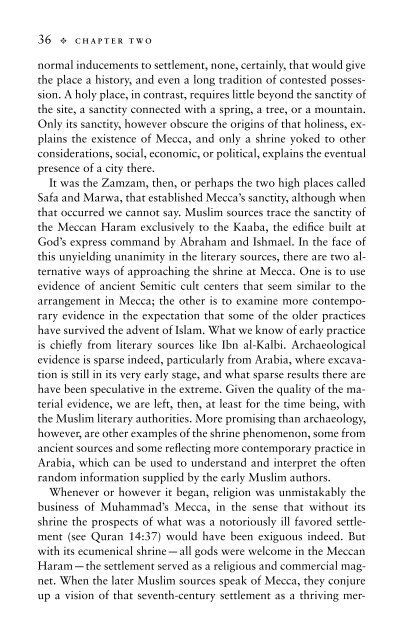Islam: A Guide for Jews and Christians - Electric Scotland
Islam: A Guide for Jews and Christians - Electric Scotland
Islam: A Guide for Jews and Christians - Electric Scotland
Create successful ePaper yourself
Turn your PDF publications into a flip-book with our unique Google optimized e-Paper software.
36 t CHAPTER TWO<br />
normal inducements to settlement, none, certainly, that would give<br />
the place a history, <strong>and</strong> even a long tradition of contested possession.<br />
A holy place, in contrast, requires little beyond the sanctity of<br />
the site, a sanctity connected with a spring, a tree, or a mountain.<br />
Only its sanctity, however obscure the origins of that holiness, explains<br />
the existence of Mecca, <strong>and</strong> only a shrine yoked to other<br />
considerations, social, economic, or political, explains the eventual<br />
presence of a city there.<br />
It was the Zamzam, then, or perhaps the two high places called<br />
Safa <strong>and</strong> Marwa, that established Mecca’s sanctity, although when<br />
that occurred we cannot say. Muslim sources trace the sanctity of<br />
the Meccan Haram exclusively to the Kaaba, the edifice built at<br />
God’s express comm<strong>and</strong> by Abraham <strong>and</strong> Ishmael. In the face of<br />
this unyielding unanimity in the literary sources, there are two alternative<br />
ways of approaching the shrine at Mecca. One is to use<br />
evidence of ancient Semitic cult centers that seem similar to the<br />
arrangement in Mecca; the other is to examine more contemporary<br />
evidence in the expectation that some of the older practices<br />
have survived the advent of <strong>Islam</strong>. What we know of early practice<br />
is chiefly from literary sources like Ibn al-Kalbi. Archaeological<br />
evidence is sparse indeed, particularly from Arabia, where excavation<br />
is still in its very early stage, <strong>and</strong> what sparse results there are<br />
have been speculative in the extreme. Given the quality of the material<br />
evidence, we are left, then, at least <strong>for</strong> the time being, with<br />
the Muslim literary authorities. More promising than archaeology,<br />
however, are other examples of the shrine phenomenon, some from<br />
ancient sources <strong>and</strong> some reflecting more contemporary practice in<br />
Arabia, which can be used to underst<strong>and</strong> <strong>and</strong> interpret the often<br />
r<strong>and</strong>om in<strong>for</strong>mation supplied by the early Muslim authors.<br />
Whenever or however it began, religion was unmistakably the<br />
business of Muhammad’s Mecca, in the sense that without its<br />
shrine the prospects of what was a notoriously ill favored settlement<br />
(see Quran 14:37) would have been exiguous indeed. But<br />
with its ecumenical shrine—all gods were welcome in the Meccan<br />
Haram—the settlement served as a religious <strong>and</strong> commercial magnet.<br />
When the later Muslim sources speak of Mecca, they conjure<br />
up a vision of that seventh-century settlement as a thriving mer-
















